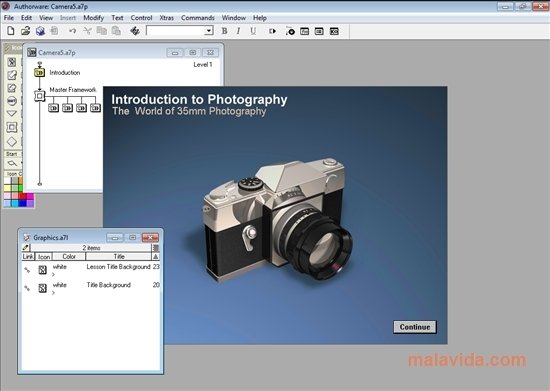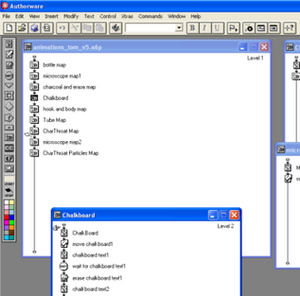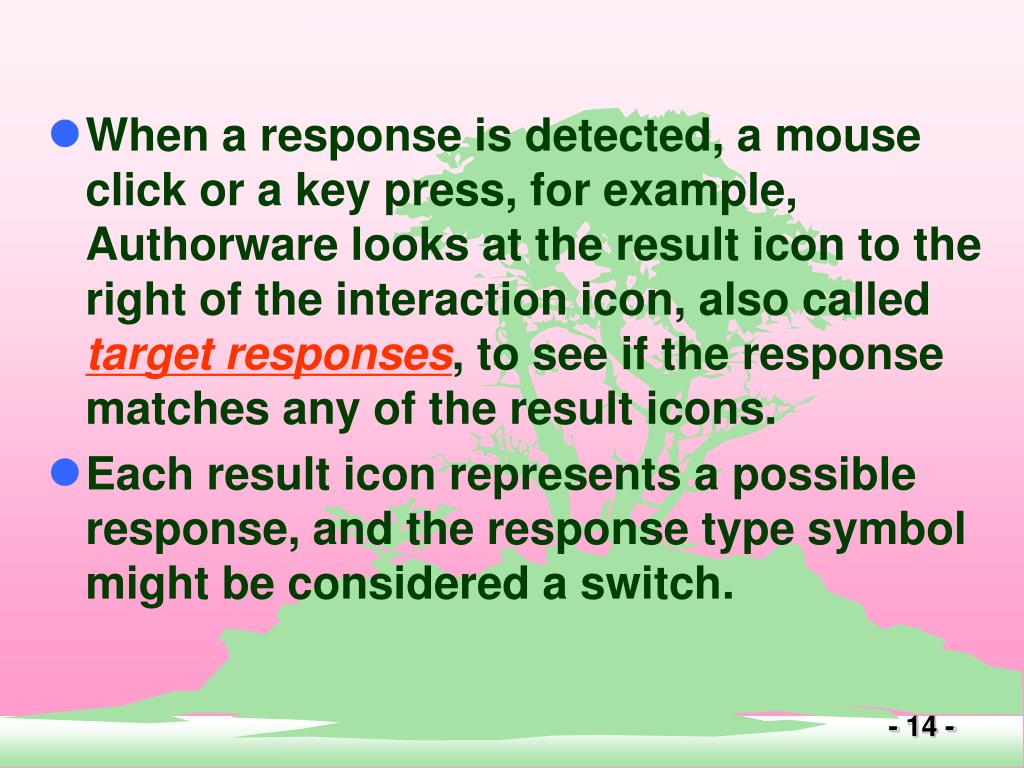Icon size Report (); Display DIfferent Backgrounds (); Simple Animations within Authorware (); Synchronizing Text with Sound/Video ( ). function of each of the icons used to program in Authorware; a tutorial through which students are given the opportunity to use Authorware to. Authorware Tutorials. Category: Teaching. Version: Program available in :In English; Program license:Trial version; Program by: PJ Rules. Vote: 1 2 3 4.
- Authorware is a sophisticated computer application that is ideal for computer-assisted instruction. The application is at once powerful yet easy to learn.
- Adobe Authorware (previously Macromedia Authorware) was an interpreted, flowchart-based, graphical programming language. Authorware is used for creating interactive programs that can integrate a range of multimedia content, particularly electronic educational technology (also called e-learning) applications.
- Authorware Examples: Showmes. Use Authorware's target area interaction to create a drag-and-drop math game. Simulate an altimeter. Animated Buttons. Create animated buttons that you can script to behave in various ways. Create pseudo-animation using character strings. Create a bar graph.
| Author: | Nesar Nar |
| Country: | Japan |
| Language: | English (Spanish) |
| Genre: | Finance |
| Published (Last): | 26 August 2008 |
| Pages: | 25 |
| PDF File Size: | 18.53 Mb |
| ePub File Size: | 15.16 Mb |
| ISBN: | 424-6-45198-121-1 |
| Downloads: | 10275 |
| Price: | Free* [*Free Regsitration Required] |
| Uploader: | Mem |
For example, one chapter shows how to make a simulation about Newton's laws of motion, called Space Shuttle Commander. This text is meant for people who are just beginning to learn Authorware but want to take full advantage of the interactive potential of computers.
Lesson Notes Subscribed users can add notes to any lesson for future reference. Start right away by clicking one of the titles below. Get started or learn new ways authorwars work. When you distribute an Authorware file containing images, sounds, and movies, you also need to distribute the Xtras and other files that Authorware uses to handle those media.
Multimedia Draw menu Show Me The source file of this Show Me example demonstrates how to dynamically authorwaree a graphical menu from the contents of an external text file. Variables and Branching Receiving variables from Flash A noted teacher and educator introduces the principles of instructional design and the cognitive learning process.
Adobe – Authorware Support Center : Authorware Concepts : Basics
You’ll learn how to order icons along the flowline and add content or functionality to each icon in your piece. Snake Show Me Download and deconstruct this ShowMe to see how to create a game in which the snake grows longer if you direct it to food using arrow keys. Colin Webster covers everything from using icons and variables to how to use Authorware with QuickTime and Flash.
Authorware Examples

Download and deconstruct this ShowMe to see how to create a game in which the snake grows longer if you direct it to food using arrow keys. Our creative, marketing and document solutions empower everyone — from emerging artists to global brands — to bring digital creations to life and deliver them to the right person at the right moment for the best results. For the complete experience, please enable JavaScript in your browser. The accompanying examples demonstrate how to apply the principles of effective instructional design to creating multimedia teaching and training materials with Authorware.
Authorware Support Center
Using active X Pt 2 Tutorixls, Middle East and Africa. Using modular logic in Authorware Modular logic is an approach to Authorware design that allows all the scripts and pieces of the flowline to be reused with a minimal amount of reworking. Using active X Pt tutirials This article has all the information you need to help you decide what you need to distribute to make your Authorware piece play properly. Using a Slidebar Orbit Show Me Control layers to give the appearance of one graphic passing in front of and behind another object.
Adobe – Authorware Support Center : Tutorial and Article Index
Framework and Quitting Starting with text and an imported graphic, this article walks you through the steps of building an Authorware piece icon by icon. Editing a map file with the Yutorials Web Packager Authorware Web Packager produces a map file that gives the Authorware Web Player the information it needs to retrieve all the segments of an Authorware piece.
This article describes how to edit the map file if you need to change file names or use transition Xtras, Director movies, of Windows DLLs. Contact us if you need to. Lifetime online access to this course. Authorware allows you to include text, sound, video, and animation.
Among the many topics you will learn are interactions, framework menus, developing quizzes, importing text, and using images. Intro to Authorware 6 Control layers to give the appearance of one graphic passing in front of and behind another object. Basics Tutorials and Articles Authorware, multimedia, and instructional tutoriaps A noted teacher and educator introduces the principles of instructional design and the cognitive learning process. Post questions and get answers from experts.
Authorware Example For Resumes
Modular logic is an approach to Authorware design that allows all the scripts and pieces of the flowline to be reused with a minimal amount of reworking. External Media Browser This Course can only be played using a subscription. Which files you tutprials to distribute When you distribute an Authorware file containing images, sounds, and movies, you tutoriala need to distribute the Xtras and other files that Authorware uses to handle those media. Click Here autborware avail a subscription Macromedia Authorware 6 is the leading authoring tool for creating e-learning, interactive web-based tutorials, and sophisticated simulations for the web, CDs, or corporate networks.
Learn how to make Ttutorials 6 work for you with Virtual Training Company’s tutorial. Download for offline access. You can play only first 3 chapters for free. Sending Variables to Flash RTF Objects Editor The source file of this Show Me example demonstrates how to dynamically create a graphical menu from the contents of an external text file. About the course Details This Course can only be played using a subscription.
One Button Publishing See all solutions for enterprise. You can track user response and results and your investment return. Building an Intro Piece On the Internet Developing for the Web.
TOP Related Posts
| Original author(s) | Macromedia |
|---|---|
| Developer(s) | Adobe Systems |
| Final release | 7.02 / 2003; 17 years ago |
| Operating system | Microsoft Windows and Mac OS X |
| Type | Integrated development environment |
| License | |
| Website | www.adobe.com/products/authorware/ |

Adobe Authorware (previously Macromedia Authorware) was an interpreted, flowchart-based, graphical programming language. Authorware is used for creating interactive programs that can integrate a range of multimedia content, particularly electronic educational technology (also called e-learning) applications. The flowchart model differentiates Authorware from other authoring tools, such as Adobe Flash and Adobe Director, which rely on a visual stage, time-line and script structure.
History[edit]
Authorware was originally produced by Authorware Inc., founded in 1987 by Dr Michael Allen. Allen had contributed to the development of the PLATO computer-assisted instruction system during the 1970s that was developed jointly by the University of Illinois and Control Data Corporation. CDC, where Allen was Director of Advanced Instructional Systems R&D, invested heavily in the development of an expansive library of interactive 'courseware' to run on the PLATO system.
PLATO courseware was developed in a unique programming language called TUTOR, which provided structures unique to learning interactions, such as answer judging and branching. TUTOR programmers were able to build powerful scripted systems that included simulations and games. However, despite the intent to create a special-purpose programming language usable by educators, and the decades of work that went into it, the TUTOR language was not easy to learn.
Authorware started as a system aimed at addressing the problems in TUTOR. Originally titled Course of Action (CoA), it was a Macintosh-only program, but produced runtime programs for both the Mac and DOS. Authorware came later and produced DOS runtime versions until the release of the first Microsoft Windows version.
Authorware used a visual interface with icons, representing essential components of the interactive learning experience. 'Authors' placed icons along a “flowline” to create a sequence of events. Icons represented such components as Display—put something on the screen, Question—ask the learner for a response, Calc—perform a calculation, read data, and/or store data, and Animate—move something around on the screen. By simply placing the icons in sequence and adjusting their properties, authors could instantly see the structure of program they were creating and, most importantly, run it to see what learners would see. On-screen changes were easy to make, even while the program was running.
Authorware became a rapid success in the marketplace, obtaining more than 80% of the market in about three years. Authorware Inc. merged with MacroMind/Paracomp in 1992 to form Macromedia. In December 2005, Adobe and Macromedia merged, under the Adobe Systems name. The most recent version of Authorware is 7.02; version 7 was released in 2003. The Authorware player has some issues with Internet Explorer 7 and later under Windows Vista due to Protected mode as well as runtime errors due to a bug in Authorware's implementation of ReadURL() Javascript function.[1]
It was generally known in the Authorware development community that version 8.0 was in production prior to the merger between the two companies, with 4 beta versions released to external testing shortly before the merger was completed. Among several other features intended for the new version, the ability to publish to Flash's SWF (ShockWave Flash) was at the top of the list. Once production shifted to Adobe's off-shore development facility in Bangalore, India, the free-flow of information that had been enjoyed between Macromedia's engineering team and its beta testers was curtailed. On Friday, August 3, 2007, after several years of keeping the development community in limbo, Adobe finally announced its plans to discontinue development of Authorware.
Usage and features[edit]

Authorware's distinctive style revolves around a central icon: the Interaction Icon. The structure of the authoring environment encourages rich interaction; complex user feed-back is not only possible but somewhat suggested by the software, rather than suggesting the usual media diffusion. This Interaction Icon allows various forms of user feedback (move object to, along a line, click an object or hot-spot; plus the usual text-entry, keypress, etc.)
The original strength in education of Authorware could be linked to its roots in pedagogical models based on constructivist views.
Authorware programs start by creating a flowline, which is a flowchart showing the structure of the developer's program. The developer can add and manage text, graphics, animation, sound and video; develop interactivity and add navigational elements such as links, buttons, and menus. Macromedia Flash and Macromedia Director movies can also be integrated into an Authorware project. Xtras, or add-ins, can also be used to extend the functionality of Authorware, which is similar to HyperCard's XCMDs. Authorware's power can be even better utilized with the use of variables, functions and expressions. Authorware can interpret both its built-in proprietary scripting language and JavaScript version 1.5.
Over time, Authorware has lost its specificity. More power was gained as more scripting added graphical design, interaction and integration features, but Authorware's special interaction-centred, clean, simple design was lost along the way. However, there are still many Fortune 500 companies that use Authorware as their main platform[citation needed].
Authorware programs can be distributed as stand-alone executable files, or over the web which requires a proprietary Authorware Web Player.
Use in electronic educational technology[edit]
Authorware is particularly well suited to creating electronic educational technology (also called e-learning) content, as it includes highly customizable templates for Computer-based training and web-based training, including student assessment tools. Working with these templates, businesses and schools can rapidly assemble multimedia training materials without needing to hire a full-fledged programmer. Intuitively-named dialog boxes take care of input and output. The flow chart model makes the re-use of lesson elements straightforward. Being both AICC- and SCORM-compliant, Authorware can be used to deliver content via any AICC or SCORM Learning Management System.
Moving beyond the templates, however, requires either the importing of interactive Flash or Director movies, or scripting, which can be done in Authorware's native scripting language or in JavaScript.
See also[edit]
References[edit]
External links[edit]

